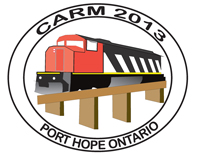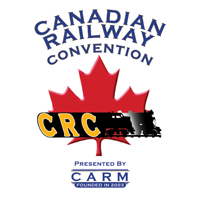Clinics
During the convention there will be a number clinics on various topics. Check the schedule for the times and room assignments of each of the clinics. Plan your weekend well and choose your clinic attendance accordingly as it may or may not not be possible to attend every clinic.
Port Hope and Area's Railway Past
Presented by Bill KnollThe building of the Montreal – Toronto section of the Grand Trunk Railway in the middle of the 19th Century sparked the construction of two lines reaching northward. First was the Cobourg and Peterborough from Cobourg. It was short lived with a lingering existence for the part between Rice Lake and Cobourg. Second, but certainly not least, out of Port Hope came the Port Hope Lindsay and Beaverton. Through successive title changes with Grand Trunk being the last, and extensions to Midland on Georgian Bay and Peterborough then later to Lakefield, those routes became part of the CNR. In the first quarter of the 20th Century the final and significant railway construction took place when both the Canadian Northern Ontario (CNoR) and CPR pushed their east west main lines through Port Hope and Cobourg. After a brief existence the CNoR became part of the fledgling CNR leaving only the CP's single track main and CN's inherited Grand Trunk double track. With ample illustration the story of the path to today's railroads in this area will be told.
Modelling Ideas from the Oshawa Railway
Presented by Keith HansenWhile the original Oshawa Railway (OR) was a street car line, we will focus on the freight operations. From the CNR main the freight line ran north across the CPR and eventually to a connection with the Canadian Northern Ontario Railway (CNoR) which was then north of Oshawa. Its main stem was only a little over 3 miles in length (it's all gone now). Fully integrated into the CNR in Dec of 1958 electric operations ceased in June of 1964. GMD SW8s prevailed as motive power thereafter. The main focus of this clinic will be on the diesel era. The OR presented some interesting features that could be incorporated into many layouts. At its zenith numerous spurs went into trackside industries with the GM north plant being the principal customer. While OR motive power was of one kind the CP and CN connections provide ample opportunity for diversity. Although parts box cars from many roads prevailed there was piggyback service, flats with crated auto parts and track maintenance machinery, gons of baled scrap, a very brief spurt of some steel coil business, lumber in boxcars and on bulkhead flats and reefer traffic. Operationally there was street running, sharp curves, through run meets and even (due to the grade on one street) the odd call for a push from a yard engine. Along with a track plan, suggestions for the aforementioned features of the OR will be viewed in both stills and action.
Mining and Railways
Presented by Gerald HarperBecause minerals are heavy and do not float they have been the driver for construction of many of the earliest railway lines on all continents. Rail surface transport of minerals from mines to markets was accompanied by dedicated rail systems built underground in the mines. Locomotive power started with people and animals and evolved to utilize almost every type of power system including electric, steam, diesel/ gasoline and gravity counterweight. Size of train system is dictated by many factors including the quantities of rock to be moved and the accessibility for delivery of components. Scratch building and kitbashing has been resorted to by every mine with a railway as they improvise and customize. This clinic will introduce examples of the smallest to the largest mining railway systems and demonstrate the logic behind mining company choices.
Photography and Video Opportunities for the Bowmanville - Belleville Corridor of CN & CP
Presented by John SoehnerEmphasis will be to show some of the better locations for trainspotting in the immediate Port Hope area and Bowmanville - Belleville corridor of the CN & CP lines. This will include the various humpback bridges from Lovekin, Stacey Rd., Dickinson Rd., Barnes Road.; the Port Hope Viaducts of both CN & CP,; CP High Trestle at Trenton, various bridges along the way including the CP Flyover just west of Cobourg; Station shots at Port Hope, Cobourg, Belleville, etc.; and Safe Trainspotting and Respect for Property, Trespassing, etc.. The presentation will relate to Locations, The Effects of Light and Location relative to the Subject Trains, and some thoughts on How to Determine the Presence of Trains and Times at particular Locations.
Onboard Video: Installation, Recording and Movie Editing
Presented by Bruce LeckieThis clinic will demonstrate the use of Onboard video as pertains to Model Railroading. Topics covered will include: Necessary equipment installation in both a car and a dummy locomotive, the use of a TCS Keep Alive decoder to power the camera, the video capture itself and some basic movie editing using Microsoft® Movie Maker.
Realistic, Removable Open Car Loads
Presented by Stephen PeesWe will show how 'removable open car loads' can enhance model railroad operations. . Removable open car loads allow you to deliver an empty car and retrieve a full one and vice versa, Just like the prototype. A variety of methods will be used to represent pulpwood, coal, woodchips, scrap metal, machinery etc., using the types of railcars that carry these commodities. The cost to make the loads is negligible and the construction fun and operational realism is very rewarding. We will also show how to use 'earth' magnets to remove the loads after inserting a washer or paper clip into the load.
GO Transit – A pictorial History
Presented by Walter ReidGO Transit, the largest commuter railway in Canada, is about to celebrate 50 years of service to the GTA and beyond. Using photos from many sources, we will explore the colourful history of GO Transit, from it's humble beginnings to the class leader in commuter transit in North America.
Wood 101
Presented by Gerry CornwellGerry Cornwell, owner of Mt. Albert Scale Lumber Company, reviews the tools and methods used for manufacturing precision wood products, and then demonstrates various techniques for detailing, weathering and colouring scale model wood.
The History of Railway Stations in Canada
Presented by Dave SavageA look at the evolutions of train stations from the early to the present day. The focus will be on architecture and its social implications with numerous examples of the stations with photographs. There will be a discussion of federal legislation to protect railway stations and a look at the recycling of stations.
Weathering Mix
Presented by Rick & Maureen HunterRick and Maureen from Hunterline will show methods and techniques about using their Weathering Mix stains. Different applications such as wood, plastics and hydrocal. Colour combinations and highlights that will make your layout more realistic.

